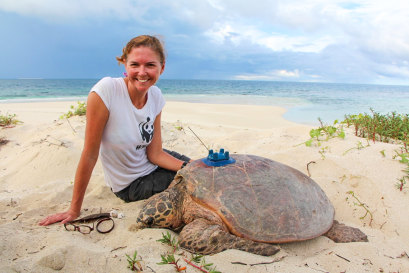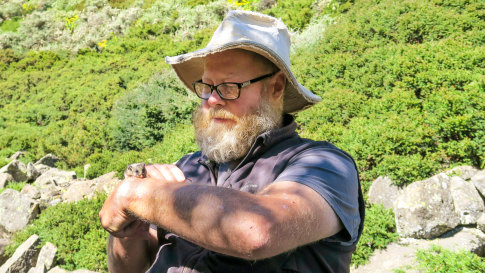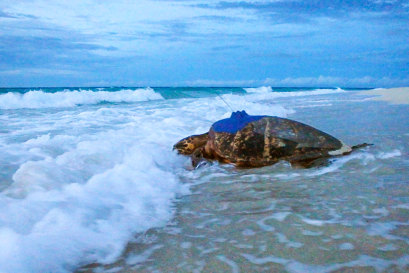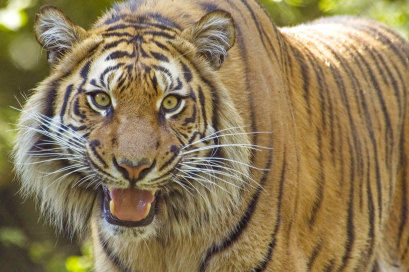This was published 8 months ago
‘Earth is sending out an SOS’: the battle to reverse wildlife losses
By Bianca Hall and Nick O'Malley
The average size of monitored wildlife populations has declined by a “catastrophic” 73 per cent over the past 50 years, reflecting the unrelenting pressures of climate change and habitat loss, a team of international scientists has found.
But a new global “nature positive” movement is aiming to turn the trend around, reversing biodiversity losses by 2030 and leading to a “full recovery” of nature by 2050.

WWF turtle conservation expert Dr Christine Madden beside a satellite-tagged hawksbill turtle on Milman Island.Credit: Christine Madden/WWF
The latest Living Planet report, compiled by WWF and the Zoological Society of London and released on Thursday, shows the average size of almost 35,000 wild populations of mammals, birds, amphibians, reptiles and fish has shrunk by 73 per cent since 1970.
In Australia, nesting female hawksbill sea turtles on Milman Island in the Great Barrier Reef have declined by 57 per cent between 1990 and 2018, raising fears the population could be locally extinct by 2036.
“What keeps me hopeful is that we have a wonderful turtle community working tirelessly to protect hawksbills and other marine turtle species across the Western Pacific and across the globe,” said WWF global marine turtle conservation lead Dr Christine Madden.
Further south, the fate of mountain pygmy possums – of which fewer than 2000 cling to existence across three alpine regions in New South Wales and Victoria – has scientists alarmed.

Wildlife biologist Dean Heinze has been recording mountain pygmy possum numbers at Mt Higginbotham for years.Credit: Dean Heinze
Wildlife biologist Dean Heinze, who has measured mountain pygmy possum numbers since 1992, said Mt Higginbotham’s possum population had declined dramatically since 2009, and was about half pre-2009 levels.
The number of female pygmy possums recorded after 2010 “dropped right off … and it’s never really recovered from that [while] male numbers have been at their lowest on record for the last two years”.
The report warns countries have a short window to place the world on a sustainable trajectory for climate change and habitat destruction, baldly stating: “It is no exaggeration to say that what happens in the next five years will determine the future of life on Earth.”
WWF Australia’s chief executive Dermot O’Gorman said Earth was “sending out an SOS”.
“Tackling the linked crises of nature loss and climate change requires a huge collective effort,” he said.
“There is still time to turn things around. To play our part, the Australian government needs to act quickly to improve national environmental laws and keep its promises to protect nature on a global level.”
Despite the bleak picture the report paints, WWF International director general Kirsten Schuijt said it wasn’t necessary to “slip into despair”.
“Fortunately, while time is running out, we are not yet past the point of no return. The power – and opportunity − are in our hands to change the trajectory.”
The report’s release on Thursday comes on the final day of the Global Nature Positive Summit in Sydney. The nature positive movement aims to stop and reverse biodiversity loss by 2030, leading to a “full recovery” of nature by 2050.

A tagged hawksbill turtle returns to the sea at Milman Island on the Great Barrier Reef.Credit: Christine Hof/WWF
Marco Lambertini, a former director of the WWF and the driving force behind the nature positive movement, said the destruction of nature had dramatically expanded since World War II.
While this increased life expectancy and cut poverty, it also resulted in the broadscale destruction of the environment, which was reaching the limit of its capacity to survive the assault.
As a result, the so-called “ecosystem services” nature provides as we extract energy, wood, fibre, water and fish from world around us is depleting, with increasing measurable impact on world economies.
“The signals are starting to come through,” Lambertini told this masthead from the summit.
“Because we have based our development on exploitation of nature, we are at risk of going back unless we find a way to stop the destruction. It is not a moral question, it is now a material question about our future prosperity, our social cohesion, our health.”
The Living Planet report found that, as things stand, international emissions reductions commitments would lead to average global temperatures increasing to such an extent they would trigger “multiple catastrophic tipping points”.
“Even though 74 per cent of nations that signed onto the 2015 Paris Agreement have strengthened their commitments to reduce or limit greenhouse gas emissions by 2030, current commitments would lead to an average global temperature increase of almost 3 degrees by the end of the century.”
Lambertini said that just as world leaders had agreed to try to arrest global warming, they needed quantifiable targets and standards to reverse the “great acceleration” of natural destruction.

Scientists estimate deforestation has caused a 10 per cent decline in the number of Sumatran tigers between 2008 and 2017.Credit: Edwin Giesbers/WWF
“Without that there won’t be any ability for companies to know whether they are really delivering something, a contribution to the nature positive outcome.”
Federal Environment Minister Tanya Plibersek said nature positive and net-zero objectives “work together”.
“They should go hand in hand because nature-based solutions should be used to achieve both our environment and our climate goals,” Plibersek said.